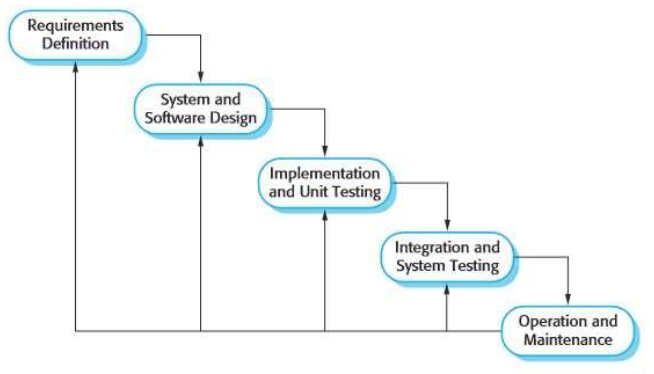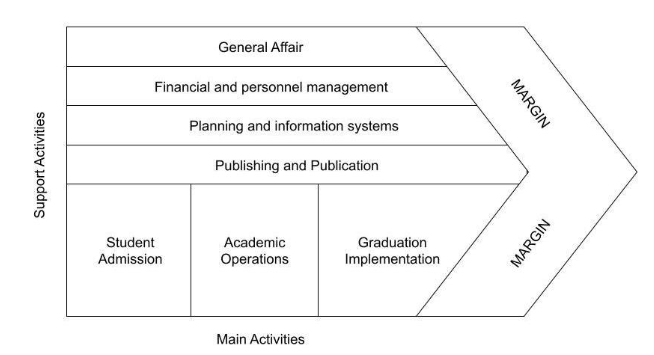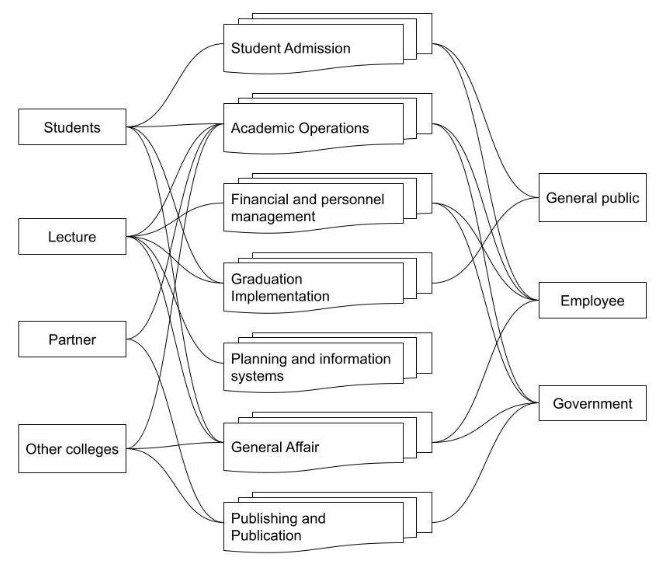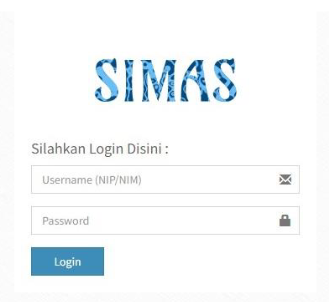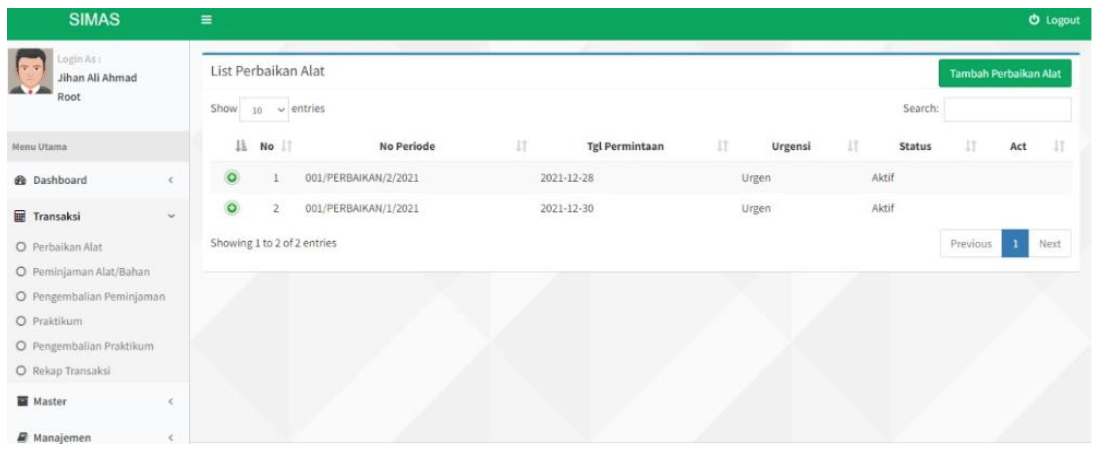Difference between revisions of "Journal:The modeling of laboratory information systems in higher education based on enterprise architecture planning (EAP) for optimizing monitoring and equipment maintenance"
Shawndouglas (talk | contribs) (Saving and updating more.) |
Shawndouglas (talk | contribs) (Saving and adding more.) |
||
| Line 185: | Line 185: | ||
| style="background-color:white; padding-left:10px; padding-right:10px;" colspan="2"|'''Table 3.''' Platform/technology architecture | | style="background-color:white; padding-left:10px; padding-right:10px;" colspan="2"|'''Table 3.''' Platform/technology architecture | ||
|- | |- | ||
! style="background-color:#dddddd; padding-left:10px; padding-right:10px;"| | ! style="background-color:#dddddd; padding-left:10px; padding-right:10px;"|Principle area | ||
! style="background-color:#dddddd; padding-left:10px; padding-right:10px;"|Description | ! style="background-color:#dddddd; padding-left:10px; padding-right:10px;"|Description | ||
|- | |- | ||
| Line 240: | Line 240: | ||
The system testing stage or testing is the stage carried out to match and observe the results of the implementation that has been carried out. System testing or testing was carried out in this study using the black-box method and the MOS. The testing process with the black-box method was carried out by testing one by one the functions that have been made to determine whether they were in accordance with user requirements and whether the output of these functions were in accordance with what was expected. As for MOS testing, it was carried out by subjective assessment of the quality associated with the system. The results of the tests carried out on the website-based Pendadaran Information System using the MOS test method, based on user acceptance testing (UAT), can be seen in Table 4. | The system testing stage or testing is the stage carried out to match and observe the results of the implementation that has been carried out. System testing or testing was carried out in this study using the black-box method and the MOS. The testing process with the black-box method was carried out by testing one by one the functions that have been made to determine whether they were in accordance with user requirements and whether the output of these functions were in accordance with what was expected. As for MOS testing, it was carried out by subjective assessment of the quality associated with the system. The results of the tests carried out on the website-based Pendadaran Information System using the MOS test method, based on user acceptance testing (UAT), can be seen in Table 4. | ||
{| | |||
| STYLE="vertical-align:top;"| | |||
{| class="wikitable" border="1" cellpadding="5" cellspacing="0" width="70%" | |||
|- | |||
| style="background-color:white; padding-left:10px; padding-right:10px;" colspan="3"|'''Table 4.''' Eligibility result by expert | |||
|- | |||
! style="background-color:#dddddd; padding-left:10px; padding-right:10px;"| | |||
! style="background-color:#dddddd; padding-left:10px; padding-right:10px;"| | |||
! style="background-color:#dddddd; padding-left:10px; padding-right:10px;"| | |||
|- | |||
| style="background-color:white; padding-left:10px; padding-right:10px;"| | |||
| style="background-color:white; padding-left:10px; padding-right:10px;"| | |||
| style="background-color:white; padding-left:10px; padding-right:10px;"| | |||
|- | |||
| style="background-color:white; padding-left:10px; padding-right:10px;"| | |||
| style="background-color:white; padding-left:10px; padding-right:10px;"| | |||
| style="background-color:white; padding-left:10px; padding-right:10px;"| | |||
|- | |||
| style="background-color:white; padding-left:10px; padding-right:10px;"| | |||
| style="background-color:white; padding-left:10px; padding-right:10px;"| | |||
| style="background-color:white; padding-left:10px; padding-right:10px;"| | |||
|- | |||
| style="background-color:white; padding-left:10px; padding-right:10px;"| | |||
| style="background-color:white; padding-left:10px; padding-right:10px;"| | |||
| style="background-color:white; padding-left:10px; padding-right:10px;"| | |||
|- | |||
| style="background-color:white; padding-left:10px; padding-right:10px;"| | |||
| style="background-color:white; padding-left:10px; padding-right:10px;"| | |||
| style="background-color:white; padding-left:10px; padding-right:10px;"| | |||
|- | |||
| style="background-color:white; padding-left:10px; padding-right:10px;"| | |||
| style="background-color:white; padding-left:10px; padding-right:10px;"| | |||
| style="background-color:white; padding-left:10px; padding-right:10px;"| | |||
|- | |||
| style="background-color:white; padding-left:10px; padding-right:10px;"| | |||
| style="background-color:white; padding-left:10px; padding-right:10px;"| | |||
| style="background-color:white; padding-left:10px; padding-right:10px;"| | |||
|- | |||
| style="background-color:white; padding-left:10px; padding-right:10px;"| | |||
| style="background-color:white; padding-left:10px; padding-right:10px;"| | |||
| style="background-color:white; padding-left:10px; padding-right:10px;"| | |||
|- | |||
|} | |||
|} | |||
==References== | ==References== | ||
Revision as of 23:55, 29 May 2023
| Full article title | The modeling of laboratory information systems in higher education based on enterprise architecture planning (EAP) for optimizing monitoring and equipment maintenance |
|---|---|
| Journal | Matrix: Jurnal Manajemen Teknologi Dan Informatika |
| Author(s) | Ifriza, Yahya N.; Veronika, Trisni W.; Suryarini, Trisni; Supriyadi, Antonius |
| Author affiliation(s) | Universitas Negeri Semarang |
| Year published | 2023 |
| Volume and issue | 13(1) |
| Page(s) | 1–11 |
| DOI | 10.31940/matrix.v13i1.1-11 |
| ISSN | 2580-5630 |
| Distribution license | Creative Commons Attribution 4.0 International |
| Website | https://ojs2.pnb.ac.id/index.php/MATRIX/article/view/928 |
| Download | https://ojs2.pnb.ac.id/index.php/MATRIX/article/view/928/516 |
|
|
This article should be considered a work in progress and incomplete. Consider this article incomplete until this notice is removed. |
Abstract
The laboratory is a place to conduct scientific research, experiments, measurements, or scientific training. Fakultas Matematika dan Ilmu Pengetahuan Alam, Universitas Negeri Semarang (FMIPA UNNES) has several laboratories distributed in each department to support student lectures. Through the implementation of practicum in the laboratory, students are expected to be able to find a concept, as well as foster scientific attitudes and critical thinking skills. Good laboratory management is expected to be able to utilize laboratory resources effectively and efficiently. Laboratory equipment must be ensured to function properly and be ready to be used for practicum. To support this, it is necessary to monitor the condition of the equipment and immediately repair the equipment if any damage is found. The current obstacle is monitoring tool repairs manually, so there are shortcomings such as poor documentation and equipment conditions that cannot be monitored online.
In this study, an information system for monitoring the maintenance of laboratory equipment in the departments in the FMIPA UNNES environment will be built. The research method begins with a literature study, initial data collection and observation, enterprise architecture planning (EAP)-based system design, system testing, system analysis, and system evaluation. This study uses the systems development life cycle (SDLC) approach to develop a monitoring information system for the maintenance of laboratory equipment. Testing is done using black box testing. From the results of development and testing, it can be concluded that the system can be used to simplify the process of managing laboratory equipment with a user acceptance testing (UAT) value of 88% suitable for use.
Keywords: enterprise architecture planning, information systems, laboratory, maintenance, optimization
Introduction
A laboratory is a place to conduct scientific research, experiments, measurements, or scientific training. Now lab management has followed technological developments, through to the application of information management systems. This is because technology can facilitate human work. One of them is the existence of digital applications. Applications have various capabilities to help human work, ranging from office applications to management, personal, entertainment, and other fields of human work. With this equipment, human tasks become easier, faster, more thorough, and more efficient. [1]
The implementation of lecture practicum in the laboratory is expected so that students can find a concept and then foster scientific attitudes and critical thinking skills. As such, laboratory management needs to be empowered effectively and efficiently. [2] Laboratory equipment must be ensured to function properly and be ready to be used for practicum. To support this, it is necessary to monitor the maintenance of the equipment systematically. The current obstacle is that monitoring of tool repair is done manually, so there are shortcomings such as poor documentation and being able to track the condition of equipment that cannot be monitored online. [3]
Currently, the Fakultas Matematika dan Ilmu Pengetahuan Alam, Universitas Negeri Semarang (FMIPA UNNES) laboratory does not yet have an information management system that can monitor the maintenance of laboratory equipment, starting from the condition of laboratory equipment to the repair process if there is damage [4]. Therefore, this study aims to create and implementan information system for monitoring the maintenance of laboratory equipment in the Department of Mathematics and Natural Sciences. Based on the description of the importance of laboratories to supporting lectures, the authors initiated the idea of researching the development of information systems that could monitor laboratory equipment maintenance. [5] This is in-line with the recommendation of the Minister of Administrative and Bureaucratic Reform (PANRB), which implies the use of IT and modern tools in completing work. [6] This monitoring system aims to perform two purposes at once, namely preventing laboratory equipment from being lost or damaged and making it easier for laboratory technicians to carry out maintenance of laboratory equipment. [7]
Methodology
The stages in this research are data collection, analysis and design, stages of developing laboratory systems, and testing information systems. [8] The stage of data collection is done by using the method of interview and observation. [9] Interviews were conducted with lecturers, students, and department managers to obtain an overview of the needs and flow of laboratory management. Meanwhile, observations were made by observing what data would be used in the management, borrowing, and processing of laboratory equipment at FMIPA UNNES. [10]
The system design stage was carried out using the Waterfall method. The Waterfall method is a sequential software development method and consists of five interrelated and influencing stages. [11] With this method, there are several stages, namely the analysis, design, implementation/coding, testing/verification, and maintenance stages. The stages of the Waterfall method are shown in Figure 1.
|
At the system design stage, a design was produced for the database using entity-relationship diagrams (ERDs) and data flow diagrams (DFDs) to describe the system framework that would later be built, making it easier to make the system needed by the user. [12] The development stage implemented the results of the design carried out. The information systems development process used the CodeIgniter framework with the PHP and JavaScript programming languages. The next stage of this research involved testing the information system for bugs using the black-box testing method. This test was carried out to find out what deficiencies and errors are in the system. [13] The system was also tested by the end users by attempting to conduct experiments directly using the system. This user testing was carried out using black-box testing and a mean opinion score (MOS). In this case, black-box testing checks one by one the functions that have been created, and whether they have been made in accordance with user requirements. [14] The MOS test involves several respondents who are encouraged to use the system, then afterwards asking them to assess several activities with a range of one to four, where a value of one represents the worst value and a value of four represents the best value. Then the average rating of all respondents was calculated so that the MOS is obtained for the system. [15]
Enterprise architecture (EA) is a logical organization for the main business processes and information technology (IT) capabilities that reflect the need for integration and standardization of the company's operating model based on the Center for Information Systems Research. [19] EA is a set of principles, methods, and models used in the design and realization of a company's organizational structure, business processes, information systems, and infrastructure. [20] Enterprise architecture planning (EAP) is a process of defining the architecture for the use of information to support the business and planning to implement the architecture. [21–23]
EAP methodologies and models are an early part of a major body of EA knowledge that is still relevant and has influenced many frameworks, methodologies, and best practices in the public and private sectors. [24–25]. As such, the research methodology used herein was adapted to the architectural modeling steps of EAP, namely planning initiation, business modeling, current system architecture and technology, development of EA models in the form of data architecture, application architecture, technology architecture, and implementation. [26]
Results and discussion
The end result of this research has been an information system for the management of laboratory equipment. This system can be used to simplify the process of data collection, borrowing, and also processing the value of laboratory equipment results. The modeling steps of the EAP were taken into account when building a blueprint for the system architecture. Following the steps of the EAP concept, the system was used to model the laboratory system at FMIPA UNNES. However, this implementation required initial EAP-related planning, business modeling, system architecture and technology consideration, development of an EA model, and implementation and testing of the system.
Initial planning
The users of this system were to be department laboratory administrators, who are tasked with inputting lab asset data in their respective departments, including conditions and suggestions for repairing tools. Also involved with initial planning were faculty administrators, who are tasked with making decisions about whether to approve or postpone the proposed repairs, and financial administrators, who are tasked with approving budget allocations/ceilings.
The initial stage of the EAP is planning, which defines the organization as an object by describing the organization's vision and mission, which is linked to the vision associated with information system planning, so that the development of the architecture can be carried out in accordance with business objectives. In accordance with its existence as a university, the core business of a university consists of three main components, namely education and teaching, community service, and research, which make up the Tri Dharma Perguruan Tinggi (Tri Dharma) of higher education. In return for providing educational services to the community, graduates will return to the community with greater purpose. Determining the future vision and mission is necessary as a guideline for determining various IT strategies needed to support the vision and mission. The selection of the planning methodology approach determines the results of the blueprint that is ultimately made.
The primary vision and mission of FMIPA UNNES is to develop mathematics and natural science education in superior educational and non-educational programs with conservation insight and positive international reputation. Second, FMIPA UNNES seeks to develop and create science and technological innovation in the fields of mathematics and natural sciences, as well as civilizations with conservation insight and international reputation. Third, the department seeks to have that science and technological innovation disseminate more broadly into the fields of mathematics and natural sciences. Fourth, the departments seeks to build and develop institutional cooperation in supporting the institutional strengthening of the department's international reputation.
The goal of FMIPA UNNES is to develop students of mathematics and natural sciences that are superior at the international level, with superior conservation insight. The department can do this by providing modern professional education services in the field of mathematics and natural sciences to the community, and implementing cooperation in the field of mathematics and natural sciences to support the strengthening of institutions of international reputation.
Business modeling
The inherent organizational structure within universities provides the impetus for conducting business modeling. The organizational structure will show what parts will be handled by a university. As a higher education institution, it focuses on the educational Tri Dharma of education and teaching, research, and community service. This paper will only discuss the fields of education and research—especially as they relate to laboratories—and not include community service. Based on the value chain concept, the main functional areas for the education model in higher education can generally be grouped into main activities and supporting activities. The main activities consist of student admissions, academic operations, and graduation. Meanwhile, supporting activities consist of activities related to resource management (general), financial management, planning and information systems, and publishing and publication. Figure 2 shows the value chain for a university's education and research model.
|
Each of the main activities in the value chain can be described. First, student admissions are all activities starting from the process of new student admissions and selection of new student administration. Second, academic operations are all activities related to teaching and learning activities during the student's academic period. Third, graduation is an activity to release students academically at the end of student studies.
There is also a variety of support activities. First, the general affairs division is the part responsible for the smooth operation of educational facilities and carries out the development of infrastructure from year to year, for both primary physical facilities and facilities to support educational activities. Second, finance and personnel management are activities that relate to financial management, determination of investment budgets and needs, and monitoring and allocation of human resources. Third, planning and information systems are activities related to the management and development of information system equipment and networks. Fourth, publishing and publication are activities related to the management and publication of journals, bulletins, and student textbooks.
After initiating the organization's business function areas by utilizing Porter's value chain[1], it is possible to arrange the decomposition structure of the business functions using a function hierarchy chart. In accordance with the scope and limitations of this journal, the functions that are decomposed are those related to academics as the main functions with elaboration on student admissions, academic operations, graduation implementation, general division, financial and staffing management, and planning and information systems, as well as publishing and publications. This is depicted in Table 1.
| ||||||||||||||||||
Figure 3 below shows the relationship between stakeholders and the main and supporting business functions in a university.
|
System architecture and technology
Assessing the current information system and technology provides an overview of the current state of information technology and systems, the future development of IT, and the desire and direction of IT development in universities today. In this step, several things need to be considered and used as the main key in conducting the analysis, namely the condition of the organization, the direction of IT development strategy, and the condition of the current information system and technology.
Development of an EA model
In building an architectural model, the first thing to do is create a data architecture. The data architecture that will be defined this time is the definition of the data usage that will be used in the application architecture later, which will be delivered at this stage according to the EAP stage in the data architecture.
An entity candidate is an entity that will be part of the EAP so that the determination can be based on the condition of the main business functions in the previously defined value chain (thus the entity that will be defined as a business entity) and based on the business entity data entities will be defined by. In accordance with the condition of the value chain, the list of business entities and their data entities can be identified as found in Table 2.
| ||||||||||||||
To describe the relationship between entities, the conceptual depiction of the relationship uses an ERD for the laboratory. The ERD is a logical data conceptual model that shows the relationship between entities in laboratories in universities. The last stage in modeling the architecture is defining the technology architecture. The EAP concept defines technology requirements that need to be provided in the business environment to run a data architecture that can manage data based on the application architecture. In other words, the technology architecture is an infrastructure requirement that must be provided to support the running of data and applications used by the organization. The principles and technology platforms were created to identify the main types of technology platforms needed to support shared data and application environments in universities. This principle is determined by considering trends and developments in information technology, business models, data architecture, application architecture, existing systems, and technologies, as well as requests and findings from business people within the organization. Table 3 shows the technology platforms that can be used to support data and applications in universities.
| ||||||||||||||||
Implementation and testing
The laboratory system development stage is the implementation stage of the design stage. At this stage of development, it is done by coding the required pages on the laboratory system using the CodeIgniter framework. Figure 4 shows the results of developing logins. The login page is a page that is used to verify users, and there are username and password inputs that must be filled in by system users to be able to enter the system. If the username and password inputs do not match, then the user cannot enter the system.
|
Admin users who have entered the correct username and password will enter the admin page. Figure 5 is a view of the admin page (Admin Data). On the admin data page, admin users can view, add, and change information, and they can delete admin data.
|
The system testing stage or testing is the stage carried out to match and observe the results of the implementation that has been carried out. System testing or testing was carried out in this study using the black-box method and the MOS. The testing process with the black-box method was carried out by testing one by one the functions that have been made to determine whether they were in accordance with user requirements and whether the output of these functions were in accordance with what was expected. As for MOS testing, it was carried out by subjective assessment of the quality associated with the system. The results of the tests carried out on the website-based Pendadaran Information System using the MOS test method, based on user acceptance testing (UAT), can be seen in Table 4.
| ||||||||||||||||||||||||||||||
References
- ↑ Tarver, E. (1 September 2021). "What Are the Primary Activities of Michael Porter's Value Chain?". Investopedia. https://www.investopedia.com/ask/answers/050115/what-are-primary-activities-michael-porters-value-chain.asp.
Notes
This presentation is faithful to the original, with only a few minor changes to presentation. Grammar was cleaned up for smoother reading. In some cases important information was missing from the references, and that information was added. The original article duplicates a paragraph in the methodology, with new references, which is confusing; for this version, the duplicated content was removed, along with the associated references, putting the article at three fewer references. Additionally, no citation was associated with the mention of Porter's value chain (originally mispelled as "Potter's") and a citation was added for this version.
